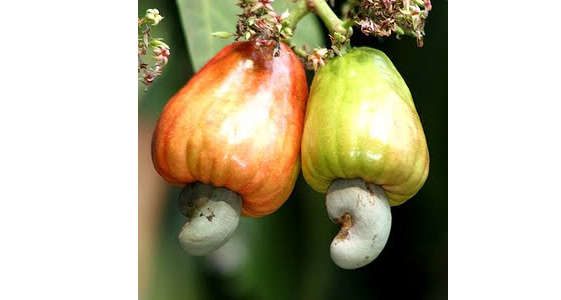
 Cashew nuts are a popular snack and food source. Cashews, unlike other oily tree nuts, contain starch to about 10% of their weight. This makes them more effective than other nuts in thickening water-based dishes such as soups, meat stews, and some Indian milk-based desserts. Many southeast Asian cuisines use cashews for this unusual characteristic, rather than other nuts.
Cashew nuts are a popular snack and food source. Cashews, unlike other oily tree nuts, contain starch to about 10% of their weight. This makes them more effective than other nuts in thickening water-based dishes such as soups, meat stews, and some Indian milk-based desserts. Many southeast Asian cuisines use cashews for this unusual characteristic, rather than other nuts.
The shell of the cashew nut is toxic, which is why the nut is never sold in the shell to consumers.
Cashew nuts are commonly used in Indian cuisine, whole for garnishing sweets or curries, or ground into a paste that forms a base of sauces for curries (e.g., korma), or some sweets (e.g., kaju barfi). It is also used in powdered form in the preparation of several Indian sweets and desserts. In Goan cuisine, both roasted and raw kernels are used whole for making curries and sweets.
Cashew, Anacardium occidentale, is an evergreen tree in the family Anacardiaceae grown for its edible fruits (nuts).
The cashew tree has a branching main trunk and characteristic domed crown. The thin foliage of the tree is limited to the ends
of the branches and is made up of oval-oblong leathery, shiny dark green leaves. The leaves are smooth with pronounced veins
and midrib and possess petioles which are swollen at their base. The tree produces numerous pinkish-white flowers on drooping
panicles and a kidney shaped true fruit (nut) which is approximately 3 cm (1.2 in) long with a gray-brown shell and develops
from a fleshy accessory fruit, sometimes referred to as the 'cashew apple'. The cashew apple is pear shaped and red to yellow in color.
Cashew trees can reach a height of 12 m (39.4 ft) and have an economic lifespan of 25 years after which time they are replaced in commercial plantations.
Cashews are high in calories. 100 g of nuts provide 553 calories. They are packed with soluble dietary fiber, vitamins, minerals and numerous health-promoting phyto-chemicals that help protect us from diseases and cancers.
They are rich in “heart-friendly” monounsaturated-fatty acids like oleic, and palmitoleic acids. These essential fatty acids help lower harmful LDL-cholesterol while increasing good HDL cholesterol. Research studies suggest that Mediterranean diet, which is rich in monounsaturated fatty acids help to prevent coronary artery disease and strokes by favoring healthy blood lipid profile.
Cashew nuts are abundant source of essential minerals. Minerals, especially manganese, potassium, copper, iron, magnesium, zinc, and selenium are concentrated in these nuts. A handful of cashew nuts a day in the diet would provide enough of these minerals and may help prevent deficiency diseases. Selenium is an important micronutrient, which functions as a co-factor for antioxidant enzymes such as Glutathione peroxidases, one of the most powerful antioxidants in the body. Copper is a cofactor for many vital enzymes, including cytochrome c-oxidase and superoxide dismutase (other minerals function as co-factors for this enzyme are manganese and zinc). Zinc is a co-factor for many enzymes that regulate growth and development, gonadal function, digestion, and DNA (nucleic acid) synthesis.
Cashews are also good in many essential vitamins such as pantothenic acid (vitamin B5), pyridoxine (vitamin B-6), riboflavin, and thiamin (vitamin B-1). 100 g nuts provide 0.147 mg or 32% of daily-recommended levels of pyridoxine. Pyridoxine reduces the risk of homocystinuria, and sideroblastic anemia. Niacin helps prevent "pellagra" or dermatitis. Additionally, these vitamins are essential for metabolism of protein, fat, and carbohydrates at the cellular level.
Further, the nuts are also carry a small amount of zea-xanthin, an important pigment flavonoid antioxidant, which selectively absorbed into the retinal macula lutea in the eyes. It is thought to provide antioxidant and protective UV ray filtering functions and helps prevent age-related macular degeneration (ARMD) in the elderly.
Maharastra
Kerala
Andhra Pradesh
Orissa
Karnataka
Tamil Nadu
Goa
West Bengal.
Cashew is essentially a tropical crop, grows best in the warm, moist and typically tropical climate. The distribution of cashew is restricted to altitudes below 700 m where the temperature does not fall below 200C for prolonged periods, although it may be found growing at elevation up to 1200 m. It is best adopted to the coastal regions. The cashew is hardy and drought resistant, but it is damaged by frost.